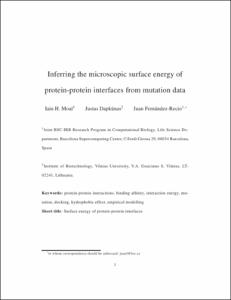Mostra el registre d'ítem simple
Inferring the microscopic surface energy of protein-protein interfaces from mutation data
| dc.contributor.author | Moal, Iain H. |
| dc.contributor.author | Dapkūnas, Justas |
| dc.contributor.author | Fernández-Recio, Juan |
| dc.contributor.other | Barcelona Supercomputing Center |
| dc.date.accessioned | 2016-05-09T15:47:58Z |
| dc.date.available | 2016-05-09T15:47:58Z |
| dc.date.issued | 2015-04 |
| dc.identifier.citation | Moal, Iain H.; Dapkūnas, Justas; Fernández-Recio, Juan. Inferring the microscopic surface energy of protein-protein interfaces from mutation data. "Proteins", Abril 2015, vol. 83, núm. 4, p. 640-650. |
| dc.identifier.issn | 0887-3585 |
| dc.identifier.uri | http://hdl.handle.net/2117/86791 |
| dc.description.abstract | Mutations at protein-protein recognition sites alter binding strength by altering the chemical nature of the interacting surfaces. We present a simple surface energy model, parameterised with empirical DDG values, yielding mean energies of -48 cal.mol−1.°A−2 for interactions between hydrophobic surfaces, -51 to -80 cal.mol−1.°A −2 for surfaces of complementary charge, and 66 to 83 cal.mol−1.°A−2 for electrostatically repelling surfaces, relative to the aqueous phase. This places the mean energy of hydrophobic surface burial at -24 cal.mol−1.°A−2. Despite neglecting configurational entropy and intramolecular changes, the model correlates with empirical binding free energies of a functionally diverse set of rigid-body interactions (r=0.66). When used to rerank docking poses, it can place near-native solutions in the top 10 for 37% of the complexes evaluated, and 82% in the top 100. The method shows that hydrophobic burial is the driving force for protein association, accounting for 50-95% of the cohesive energy. The model is available opensource from http://life.bsc.es/pid/web/surface_energy/ and via the CCharpPPI web server http://life.bsc.es/pid/ccharppi/. |
| dc.description.sponsorship | This research was in part supported by postdoctoral fellowship funded by European Union Structural Funds project ”Postdoctoral Fellowship Implementation in Lithuania”. The research leading to these results has received funding from the People Programme (Marie Curie Actions) of the European Unions Seventh Framework Programme (FP7/2007-2013) under REA grant agreement PIEF-GA- 2012-327899, and the SpanishMinistry of Science and Innovation project [BIO2013- 48213-R]. The authors declare no conflict of interests. |
| dc.format.extent | 11 p. |
| dc.language.iso | eng |
| dc.publisher | Wiley |
| dc.subject | Àrees temàtiques de la UPC::Enginyeria electrònica |
| dc.subject.lcsh | Protein-protein interactions |
| dc.subject.other | Protein–protein interactions |
| dc.subject.other | Binding affinity |
| dc.subject.other | Interaction energy |
| dc.subject.other | Mutation |
| dc.subject.other | Docking |
| dc.subject.other | Hydrophobic effect |
| dc.subject.other | Empirical modeling |
| dc.title | Inferring the microscopic surface energy of protein-protein interfaces from mutation data |
| dc.type | Article |
| dc.subject.lemac | Proteïnes |
| dc.identifier.doi | 10.1002/prot.24761 |
| dc.description.peerreviewed | Peer Reviewed |
| dc.relation.publisherversion | https://onlinelibrary.wiley.com/doi/abs/10.1002/prot.24761 |
| dc.rights.access | Open Access |
| dc.description.version | Postprint (author's final draft) |
| dc.relation.projectid | info:eu-repo/grantAgreement/EC/FP7/327899/EU/Exploring the evolution of protein-protein interactions and their networks using biophysical models/EEPPIBM |
| dc.relation.projectid | info:eu-repo/grantAgreement/MINECO//BIO2013-48213-R/ES/DESARROLLO DE NUEVAS METODOLOGIAS DE DOCKING ENTRE PROTEINAS PARA LOS RETOS DE INTERACTOMICA Y MEDICINA PERSONALIZADA/ |
| local.citation.publicationName | Proteins |
| local.citation.volume | 83 |
| local.citation.number | 4 |
| local.citation.startingPage | 640 |
| local.citation.endingPage | 650 |
Fitxers d'aquest items
Aquest ítem apareix a les col·leccions següents
-
Articles de revista [374]


